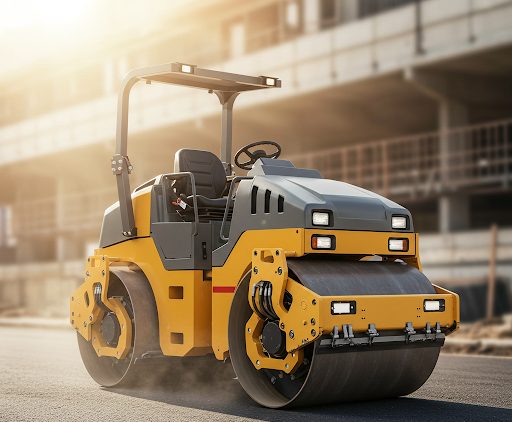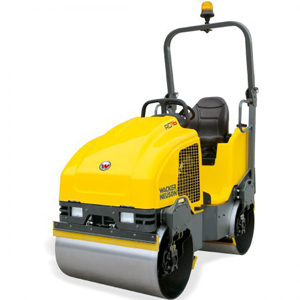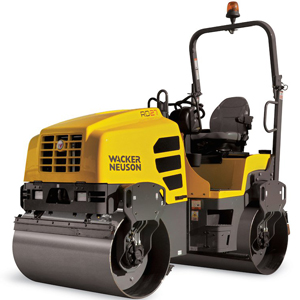Double drum vibratory rollers are specialized compaction equipment used to pack down soil, asphalt, and other materials in construction projects. These machines feature two drums that vibrate to create even, consistent pressure across surfaces. Unlike single drum models, double drum vibratory rollers excel in both road compaction and finishing work on various surfaces.
In this article, we’ll compare how these rollers perform in different settings, from highway construction to soil stabilization. You’ll discover the unique design features that make these machines so effective and see real performance data from actual job sites. Our insights come from hands-on experience with vibratory rollers and careful testing of compaction results. Whether you’re working with asphalt or soil, understanding the right compaction techniques can save time and improve quality on your projects.
Understanding Double Drum Vibratory Rollers
Double drum vibratory rollers are specialized compaction equipment designed with two cylindrical drums that vibrate to compress materials. These machines are essential in construction and road building projects where proper compaction is crucial for durability and stability. Unlike their single drum counterparts, double drum models apply pressure and vibration from both drums, making them ideal for asphalt compaction and work on granular materials.
How Double Drum Rollers Work
The power of these machines comes from their design. Both drums create vibratory compaction through internal eccentric weights that spin rapidly. This generates a compaction force that:
- Pushes air out from between material particles
- Rearranges particles into tighter formations
- Creates denser, more stable surfaces
Most models allow operators to control vibration frequency and amplitude settings to match specific job requirements. This flexibility helps achieve optimal soil density improvement across different materials.
Applications and Benefits
Double drum vibratory roller applications span various construction scenarios:
- Road compaction – Creating smooth, durable asphalt surfaces
- Soil compaction – Preparing stable foundations before construction
- Pavement construction – Finishing and smoothing new roadways
- Infrastructure projects – Airport runways, parking lots, and industrial floors
Their key advantages include:
- Even compaction across the entire surface
- Higher efficiency than static rollers
- Better finish quality on asphalt surfaces
- Versatility across different material types
The right roller compaction performance depends on matching the machine to your specific project needs, material type, and desired density. When properly selected and operated, double drum vibratory rollers deliver consistent results that meet engineering standards for long-lasting construction.
Comparative Analysis: Road vs. Soil Compaction
Double drum vibratory rollers serve different purposes when used for road compaction versus soil compaction. In asphalt compaction, these machines excel at creating smooth, dense surfaces needed for durable roads. The drums apply even pressure across the full width of fresh asphalt. For soil stabilization and earth compaction, these same machines compact loose materials to form solid bases for construction.
The key difference lies in how the compaction force works on each material. Asphalt requires careful pressure to avoid crushing aggregate while still removing air voids. Soil compaction needs deeper force penetration to reach lower layers. This is why operators adjust vibration amplitude settings based on the job type. Data shows that roller compaction performance varies greatly between applications. For asphalt, operators typically use:
- Lower amplitude settings (0.3-0.8 mm)
- Higher frequencies (50-67 Hz)
- Fewer passes (4-6)
For soil, the settings change to:
- Higher amplitude (0.8-1.8 mm)
- Lower frequencies (30-40 Hz)
- More passes (6-10)
The roller compaction pressure must be carefully controlled. Too much force on asphalt can damage the mix structure. Too little on soil leaves unstable ground that will settle later.
Compaction Efficiency Metrics
The effectiveness of vibratory compaction depends on several key metrics:
- Vibration frequency – measured in hertz (Hz), controls how many impacts occur per second
- Amplitude – the height of each vibration movement
- Roller weight – provides static force that works with vibration
These factors combine differently for road construction compaction versus granular compaction. In road work, higher frequencies with lower amplitudes create smooth surfaces without damaging the asphalt mix. For soil and aggregate, lower frequencies with higher amplitudes drive compaction deeper.
Compaction testing confirms if the proper density is achieved. For roads, nuclear density gauges measure the finished asphalt. For soil, engineers use proctor tests to compare field density with lab standards. Modern roller testing methods include continuous compaction control systems that map the entire work area. These systems help operators identify soft spots that need more attention, making both road compaction and soil compaction more efficient and thorough. The right balance of weight, vibration, and passes ensures quality results whether building roads or preparing foundations.
Innovative Compaction Technologies in Double Drum Rollers
Today’s double drum vibratory rollers feature cutting-edge technology that has transformed road construction. Modern rollers now include smart systems that measure soil density in real time. These innovations help crews achieve better compaction quality with fewer passes. New sensor systems in these machines provide operators with instant feedback. They show exactly when the right compaction level has been reached. This prevents over-compaction and saves time and fuel. The latest models also feature improved vibration technology that adjusts automatically to different materials. Road stabilization techniques have also advanced with these new technologies. Rollers can now adapt their compaction force to match specific project needs. Whether working with asphalt, soil, or aggregates, these machines deliver consistent results.
Advances in Vibration Control
Modern double drum rollers offer remarkable improvements in vibration frequency control. Operators can now fine-tune settings between 2,000-4,000 vibrations per minute. This precise control lets crews match the exact needs of different materials. Amplitude adjustment is another major breakthrough. New rollers allow operators to change the height of each vibration:
- Low amplitude for thin asphalt layers
- Medium settings for base materials
- High amplitude for thick soil layers
These adjustments are far superior to static compaction methods. While static rollers rely only on weight, vibratory compaction combines weight with controlled vibration. This combination achieves proper density much faster. The result is impressive gains in roller system efficiency. Projects that once took days can now be completed in hours. Crews achieve better compaction speed while using less fuel. The improved technology also reduces operator fatigue since fewer passes are needed.
Field Performance and Practical Experiences
Operators who use double drum vibratory rollers daily share valuable insights about these machines. On asphalt jobs, crews report that maintaining consistent speed is crucial for quality results. One road crew in Texas found that slower speeds (2-3 mph) produced better asphalt compaction than faster passes, especially during hot weather.
For soil compaction projects, the difference is clear. A construction team in Colorado noted their double drum roller achieved target density in just 3-4 passes on granular soils, while clay soils required 6-8 passes with adjusted vibration settings. This shows how soil type directly affects compaction effectiveness. Maintenance issues come up often in operator feedback. Drum bearings typically need attention after 1,000-1,500 hours of use. Water spray systems frequently clog in dusty conditions, affecting asphalt work quality. Many crews now perform daily spray nozzle checks to prevent this common problem.
Weather impacts performance significantly. During a highway project in Florida, crews found that vibratory compaction was 30% less effective during heavy rain. They adjusted by increasing passes and reducing vibration frequency to prevent material displacement.
Real-world Operational Insights
Smart operators make key adjustments to improve results. For efficient soil compaction, experienced teams recommend:
- Starting with static passes before activating vibration
- Using high amplitude settings for deep compaction of thick lifts
- Switching to low amplitude for final passes to prevent over-compaction
- Overlapping passes by 6-8 inches for uniform density
Vibratory roller maintenance makes a big difference in long-term performance. Teams that follow strict maintenance schedules report 40% fewer breakdowns. Simple practices like daily drum cleaning and proper fluid checks extend machine life by years. Environmental factors require specific adjustments. In cold weather below 50°F, operators find that extending compaction time by 25% helps achieve target density in asphalt. For sandy soils, reducing vibration frequency while maintaining amplitude improves compaction force distribution.
The most successful teams monitor drum bounce carefully. When operators notice excessive bouncing, they immediately reduce speed or vibration intensity to prevent surface damage. This simple observation prevents costly rework on both soil and asphalt projects.
Expert Tips on Operating & Maintenance
Double drum vibratory rollers are key machines in construction compaction. Using them correctly helps build better roads and foundations. Let’s look at how to get the most from your roller while keeping it running well. For top performance, always check fluid levels before starting work. This includes fuel, hydraulic oil, and water for the sprinkler system. Make sure drums are clean before use – material stuck to drums can create uneven surfaces.
When operating on asphalt, start with low vibration settings and increase gradually. This prevents over-compaction that can damage new pavement. For soil compaction, higher settings may be needed, but always follow project specs.
Maintenance tips:
- Check drum bearings weekly
- Clean water spray nozzles daily
- Inspect vibration systems monthly
- Change hydraulic fluid as scheduled
- Keep all bolts tight, especially on drum frames
Regular care prevents costly breakdowns and extends your roller’s life. Most problems start small – fixing them early saves money.
Best Practices for Effective Vibration Settings
The right vibration settings make all the difference in compaction quality. Here’s how to dial in your machine:
For asphalt compaction use:
- Lower amplitude (0.3-0.5 mm)
- Higher frequency (50-67 Hz)
- Slower travel speed (2-4 km/h)
For soil and aggregate compaction:
- Higher amplitude (0.8-1.2 mm)
- Lower frequency (30-40 Hz)
- Moderate travel speed (3-6 km/h)
Always make test passes and measure density. Adjust settings based on results, not just what worked on other jobs. Different materials need different approaches. Training operators is just as important as maintaining equipment. Even the best roller won’t perform well with an untrained operator. Make sure everyone knows how to:
- Read the material being compacted
- Adjust settings for changing conditions
- Recognize when compaction is complete
- Track maintenance needs
Remember that vibration power should match the job, not exceed it. Too much vibration wastes fuel, increases wear on your roller, and can damage nearby structures. The goal is optimal density with minimal passes.
Evaluating Compaction Impact for Project Success
Knowing if your compaction project succeeded is vital for road quality and structure durability. Double drum vibratory rollers are key tools in achieving proper compaction, but how do you measure their effectiveness? Let’s explore practical ways to evaluate compaction results.
Measuring Road Quality Improvement
The true test of compaction effectiveness comes from measuring what you’ve achieved. Here are reliable methods to assess your compaction results:
- Density Testing: Use nuclear density gauges to check if soil or asphalt has reached target density levels.
- Field Testing: Perform plate load tests to measure the bearing capacity of compacted surfaces.
- Visual Inspection: Look for a smooth, uniform surface without roller marks or soft spots.
- Core Sampling: Extract samples to verify thickness and density throughout the compacted area.
When evaluating road compaction, compare your results with project specifications. Most highway projects require 95-98% of maximum density for base materials. Asphalt compaction typically needs 92-97% depending on the mix design.
Setting Realistic Compaction Targets
Compaction targets vary based on material and project requirements. Here’s what to aim for:
- Soil compaction: 95-98% of maximum dry density
- Granular compaction: 95% of maximum density
- Asphalt compaction: 92-97% of theoretical maximum density
Compare your double drum vibratory roller results against these benchmarks:
| Material Type | Traditional Equipment | Double Drum Vibratory Roller | Improvement |
|---|---|---|---|
| Asphalt | 4-6 passes needed | 2-4 passes needed | 33-50% fewer passes |
| Granular soil | 90-93% compaction | 95-98% compaction | 5-8% better density |
| Clay soil | Inconsistent results | Uniform compaction | More reliable outcome |
For infrastructure compaction projects, success means achieving uniform density throughout. This prevents future settlement issues and extends pavement life by 30-40%. Remember that soil stabilization assessment requires checking both immediate compaction and long-term performance. Use falling weight deflectometer tests to verify the structural integrity of your compacted layers. By properly measuring your compaction results, you’ll ensure your double drum vibratory roller applications deliver lasting quality while optimizing your construction time and resources.
What’s the Next Step?
Double drum vibratory rollers stand as key players in modern construction. They excel in both road and soil compaction tasks with their dual drum design. The right settings for vibration frequency and amplitude make all the difference in project success. Today’s rollers come with smart tech that helps track and improve compaction performance. For best results, follow proper use tips and keep up with maintenance checks. Remember that good roller operation leads to stronger roads and more stable soil. With the right know-how, these machines help build infrastructure that lasts longer and performs better.
Explore our wide range of top-brand construction tools and equipment today! Whether you’re looking to rent or buy, Rentalex has everything you need for your next project. Visit our Tampa location or contact us at (813)971-9990 for more information.











